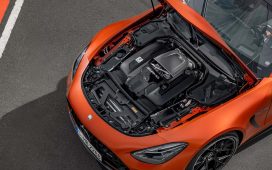The automotive landscape is shifting once more, with hybrids making a return to the forefront of discussions about sustainable transportation. Ahead of its upcoming launch in Australia, Leapmotor International is introducing the C10 REEV (Range Extending Electric Vehicle) SUV, heralded as a crucial innovation amid the country’s challenges with charging infrastructure.
Leapmotor International, a collaboration between European automotive group Stellantis and Chinese manufacturer Leapmotor, first unveiled the C10 electric vehicle in 2023. Building on this momentum, the C10 REEV aims to tackle the issues relating to range anxiety that many consumers face with standard electric vehicles.
The new C10 REEV features a 158kW electric motor coupled with a 1.5-litre petrol engine designed to charge a 28.4kWh battery, potentially extending its range to nearly 1,000 kilometers. This capability addresses a significant demand in Australia, where vast distances and limited charging stations can hinder the adoption of purely electric vehicles.
Leapmotor’s CEO emphasized that this hybrid technology offers a viable solution for those wary of conventional electric cars, which may only cover up to 420 kilometers on a single charge. The REEV variant not only promises enhanced range but also boasts efficient fuel consumption, reportedly consuming just 0.4 liters per 100 kilometers combined.
As the automotive industry grapples with various sustainability challenges, the C10 REEV represents a pragmatic approach that could rejuvenate interest in hybrids and pave the way for broader acceptance of electric mobility.
Exploring the Broader Implications of Range Extending Electric Vehicles
The emergence of the C10 REEV in the Australian market signals a pivotal shift not only within the automotive industry but also in societal attitudes towards sustainable transportation. This transition reflects a growing consensus that widespread adoption of electric vehicles (EVs) requires solutions that accommodate real-world challenges, notably range anxiety and charging infrastructure shortfalls.
The introduction of REEV technology could potentially alter consumer behavior, encouraging a more extensive embrace of hybrid vehicles. As range-extending capabilities become a focal point, commuters may feel more secure in their decision to transition away from traditional combustion engines. This shift has broader implications for societal norms around car ownership, potentially fostering a culture that prioritizes sustainability, efficiency, and resilience in transportation.
Moreover, the advent of vehicles like the C10 REEV could catalyze significant economic shifts. The automotive sector, often seen as a cornerstone of many economies, might pivot from a solely electric focus to a hybrid model that adapts to different markets. Australia, with its unique geography and charging infrastructure challenges, could serve as a testbed for hybrid technologies, influencing global strategies in regions that face similar obstacles. This localized innovation may encourage investment in infrastructure improvements, enhancing the overall electric vehicle ecosystem.
Environmental impacts are another critical consideration. While the C10 REEV offers a pathway to reducing emissions compared to traditional fossil fuel vehicles, it also raises questions about the sustainability of hybrid technology. The reliance on petrol engines, even in a reduced capacity, must be balanced with the long-term goal of a fully electrified transportation network. Transitioning toward hybrids could slow the shift needed to mitigate climate change if not coupled with policies that prioritize the phasing out of fossil fuels entirely.
Looking forward, the future of transportation could see a convergence of technologies, where vehicles like the C10 REEV coexist with fully electric and alternative fuel options. This hybrid approach may not be the final destination; rather, it may represent a stepping stone toward a more complex landscape of mobility solutions. As automakers respond to consumer needs and regulatory pressures, future trends might include enhanced battery technologies, bi-directional charging, and further integration of renewable energy sources.
In conclusion, the introduction of the C10 REEV brings a dual promise: it addresses present-day concerns while hinting at a path forward for sustainable transportation. The long-term significance lies in whether this innovation can effectively bridge the gap to a future where electric mobility is not only viable but thriving, ultimately fostering an environmentally-friendly and economically robust automotive landscape.
The Rise of REEV: Understanding Leapmotor’s C10 and Its Impact on Australia’s Automotive Market
The introduction of Leapmotor International’s C10 REEV SUV marks a pivotal moment in the automotive sector, especially for Australian consumers contemplating the shift to greener transportation options. As discussions around electric vehicles (EVs) intensify, the C10 REEV is positioned uniquely by combining electric efficiency with range-extending capabilities. In this article, we explore the potential of this hybrid approach, offering insights, FAQs, and predictions regarding its impact on the market.
FAQs about the C10 REEV
Q: What is a Range Extending Electric Vehicle (REEV)?
A: A REEV is a vehicle that primarily propels itself using electric power but is equipped with an internal combustion engine that functions as a generator to recharge the battery. This technology alleviates range anxiety typically seen in standard electric vehicles.
Q: How far can the C10 REEV travel on a single charge?
A: The C10 REEV can theoretically travel nearly 1,000 kilometers thanks to its combination of electric motor and petrol engine, effectively extending its range beyond many purely electric models.
Q: What are the advantages of choosing a hybrid like the C10 REEV over a traditional electric vehicle?
A: Key advantages include reduced worries about running out of charge, better fuel efficiency in long drives, and the ability to rely on petrol in areas with limited charging infrastructure.
Pros and Cons of the Leapmotor C10 REEV
Pros:
1. Extended Range: With a potential travel distance of nearly 1,000 kilometers, it alleviates the range anxiety commonly associated with electric vehicles.
2. Efficient Fuel Consumption: The vehicle boasts an impressive fuel consumption rate of just 0.4 liters per 100 kilometers, offering consumers savings on fuel costs.
3. Sustainability: The C10 REEV promotes a more gradual transition to electric mobility, appealing to consumers skeptical about fully electric vehicles.
Cons:
1. Complexity: The dual powertrain may introduce more complexity in maintenance compared to straightforward electric vehicles.
2. Environmental Concerns: While it encourages EV adoption, the reliance on a petrol engine might deter environmentally-conscious buyers seeking purely electric solutions.
3. Infrastructure Dependency: The success of hybrid models like the C10 REEV remains heavily reliant on the availability of charging stations and overall infrastructure support.
Potential Controversies and Market Predictions
There’s growing debate in the automotive industry regarding the effectiveness of hybrids in the long-term push towards fully electric vehicles. Analysts suggest that while models like the C10 REEV may drive initial interest in EVs, they could also delay the necessary infrastructural investments needed for more robust battery charging systems.
Moreover, with the Australian market being exceptionally vast, there are predictions that the C10 REEV could establish a significant foothold, potentially leading to increased competition among automakers to develop similar hybrid solutions. As consumer habits shift towards sustainability, manufacturers may need to prioritize more electrified options.
Quick Tips for Potential Buyers
– Evaluate Your Driving Habits: If you often cover long distances in areas with limited charging stations, the C10 REEV could be an ideal solution to meet your needs.
– Research Local Infrastructure: Before purchasing, investigate the availability of charging stations in your region to maximize the potential of the vehicle’s electric capabilities.
– Consider Total Cost of Ownership: Factor in fuel costs, maintenance, and potential government incentives for green vehicles to fully understand the vehicle’s economic impact.
In conclusion, as Leapmotor introduces the C10 REEV to Australia, it represents not just an innovative vehicle but also a broader trend in consumer preferences towards versatility in sustainable transportation. By bridging the gap between traditional combustion engines and fully electric vehicles, the C10 REEV could play an essential role in transforming the automotive landscape.








